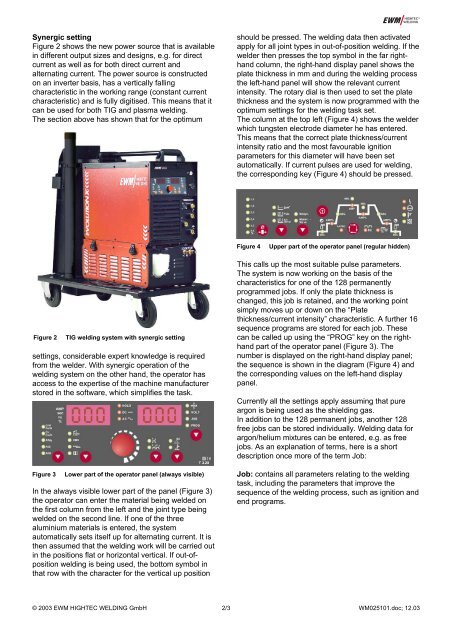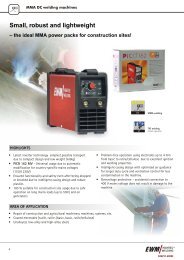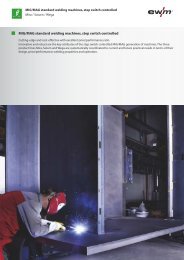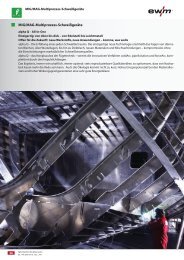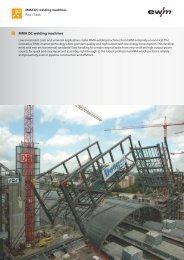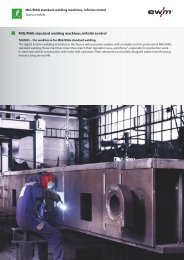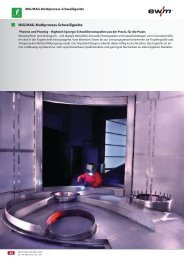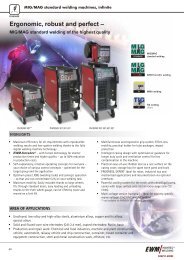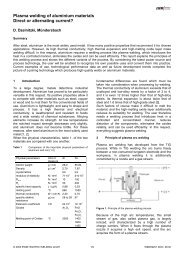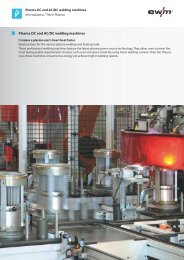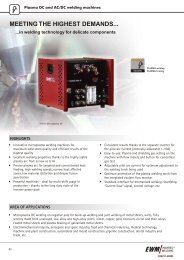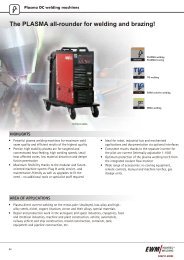Synergic Setting of TIG Systems - Ewm-sales.co.uk
Synergic Setting of TIG Systems - Ewm-sales.co.uk
Synergic Setting of TIG Systems - Ewm-sales.co.uk
You also want an ePaper? Increase the reach of your titles
YUMPU automatically turns print PDFs into web optimized ePapers that Google loves.
<strong>Synergic</strong> settingFigure 2 shows the new power source that is availablein different output sizes and designs, e.g. for directcurrent as well as for both direct current andalternating current. The power source is <strong>co</strong>nstructedon an inverter basis, has a vertically fallingcharacteristic in the working range (<strong>co</strong>nstant currentcharacteristic) and is fully digitised. This means that itcan be used for both <strong>TIG</strong> and plasma welding.The section above has shown that for the optimumshould be pressed. The welding data then activatedapply for all joint types in out-<strong>of</strong>-position welding. If thewelder then presses the top symbol in the far righthand<strong>co</strong>lumn, the right-hand display panel shows theplate thickness in mm and during the welding processthe left-hand panel will show the relevant currentintensity. The rotary dial is then used to set the platethickness and the system is now programmed with theoptimum settings for the welding task set.The <strong>co</strong>lumn at the top left (Figure 4) shows the welderwhich tungsten electrode diameter he has entered.This means that the <strong>co</strong>rrect plate thickness/currentintensity ratio and the most favourable ignitionparameters for this diameter will have been setautomatically. If current pulses are used for welding,the <strong>co</strong>rresponding key (Figure 4) should be pressed.Figure 4Upper part <strong>of</strong> the operator panel (regular hidden)Figure 2settings, <strong>co</strong>nsiderable expert knowledge is requiredfrom the welder. With synergic operation <strong>of</strong> thewelding system on the other hand, the operator hasaccess to the expertise <strong>of</strong> the machine manufacturerstored in the s<strong>of</strong>tware, which simplifies the task.Figure 3<strong>TIG</strong> welding system with synergic settingLower part <strong>of</strong> the operator panel (always visible)In the always visible lower part <strong>of</strong> the panel (Figure 3)the operator can enter the material being welded onthe first <strong>co</strong>lumn from the left and the joint type beingwelded on the se<strong>co</strong>nd line. If one <strong>of</strong> the threealuminium materials is entered, the systemautomatically sets itself up for alternating current. It isthen assumed that the welding work will be carried outin the positions flat or horizontal vertical. If out-<strong>of</strong>positionwelding is being used, the bottom symbol inthat row with the character for the vertical up positionThis calls up the most suitable pulse parameters.The system is now working on the basis <strong>of</strong> thecharacteristics for one <strong>of</strong> the 128 permanentlyprogrammed jobs. If only the plate thickness ischanged, this job is retained, and the working pointsimply moves up or down on the “Platethickness/current intensity” characteristic. A further 16sequence programs are stored for each job. Thesecan be called up using the “PROG” key on the righthandpart <strong>of</strong> the operator panel (Figure 3). Thenumber is displayed on the right-hand display panel;the sequence is shown in the diagram (Figure 4) andthe <strong>co</strong>rresponding values on the left-hand displaypanel.Currently all the settings apply assuming that pureargon is being used as the shielding gas.In addition to the 128 permanent jobs, another 128free jobs can be stored individually. Welding data forargon/helium mixtures can be entered, e.g. as freejobs. As an explanation <strong>of</strong> terms, here is a shortdescription once more <strong>of</strong> the term Job:Job: <strong>co</strong>ntains all parameters relating to the weldingtask, including the parameters that improve thesequence <strong>of</strong> the welding process, such as ignition andend programs.© 2003 EWM HIGHTEC WELDING GmbH 2/3 WM025101.doc; 12.03


